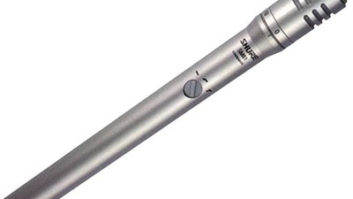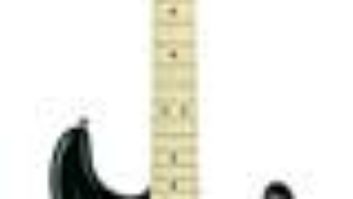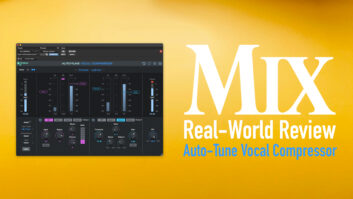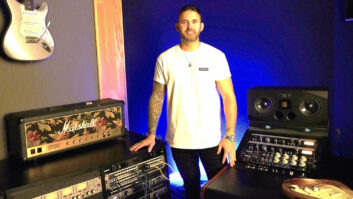
If there’s one thing you’ll find on just about every stage this summer, it’s a handheld vocal microphone. Wired handhelds are the “grunts” of the live sound industry: Forever subject to physical stress and often screamed at, these mics put up with more artist abuse than a tired tour manager.
The minimalist appearance of many handhelds is hardly indicative of what lies “under the hood”: Manufacturers are incorporating exotic materials such as boron, beryllium and neodymium to achieve studio-quality audio while increasing a performance’s reliability and consistency. To increase the capsule’s lifespan and minimize handling noise, internal shock-mounting is the norm. The use of “humbucking” technology has increased, helping mics battle the increased RF common on many stages today. More models now offer silent on/off switches (either standard or as an option) and user-adjustable highpass filters. Many handheld condenser mics will run from phantom power as low as 11 volts, providing reliable operation from just about any mixer with phantom power.
Below, we present the top handheld mics on the market. Due to the sheer number of handheld models available, this survey was limited strictly to top-of-the-line wired dynamic and condenser models.
DYNAMIC CONDENSER CONTENDERS
AKG C 5900M
A supercardioid dynamic vocal mic, AKG‘s (www.akgusa.com) D 3800M ($263) features the company’s VariMotion diaphragm technology. The VariMotion diaphragm’s thickness varies across the diameter, allowing it to be tuned to a desired resonant frequency. A double suspension for the diaphragm yields significant suppression of mechanical noise, and a humbucking coil suppresses electronic interference. Three output modules are available for the D 3800M, including the standard XLR connector, XLR/S with on/off switch (D 3800MS) and the TM40 transmitter module for wireless operation. Frequency response is stated as 50 to 20k Hz with a max. SPL of 147 dB (1% THD); impedance is 600 ohms.
The C 5900M ($418) from AKG is a supercardioid condenser with a capsule suspended by a spider-type shock-mount for handling noise suppression. A spring steel wire-mesh grille increases durability and reliable control of pops and wind noise. The C 5900M includes switches for bass cut (12 dB/octave at 100 Hz, 6 dB/octave at 150 Hz) and output level (0/+6 dB), enabling the mic to drive less-sensitive mic inputs. Output module options include a standard XLR connector with gold-plated contacts and the TM40 transmitter module. The C 5900M may be powered via phantom supply from 9 to 52 volts. Frequency range is 20 to 20k Hz with a max. SPL of 139 dB (1% THD); impedance is 200 ohms.
The APEX381 ($109) dynamic mic from Apex Electronics (www.apexelectronics.com) uses a neodymium magnet and aluminum alloy voicecoil to yield high output. A tight cardioid pattern maximizes gain before feedback, and an internal double shock-mount system significantly reduces handling noise. The APEX381 has a leather-feel finish for positive grip. Frequency response is 50 to 18k Hz with a max SPL of 140 dB; impedance is 300 ohms.
Compact size and light weight make the APEX115 ($159) hypercardioid condenser a smart choice for situations where high performance is required from an unobtrusive mic. The mic requires phantom power to operate (48V DC). Frequency response is 70 to 19k Hz with an S/N ratio of 65 dB.

Audio-Technica AES5400
Audio-Technica‘s (www.audio-technica.com) Artist Elite AE6100 ($289) hypercardioid mic was designed for smooth on-axis response, maximum feedback rejection and low handling noise. Protecting the AE6100 against vocal popping is a hardened-steel grille lined with a fine steel mesh and a layer of open-cell foam. A foam disc positioned on top of the element provides an additional layer of pop protection. Frequency response is shaped to cut through stage monitor mixes and provides clean articulation. Frequency response is 60 to 15k Hz; impedance is 250 ohms. The mic exhibits an open circuit sensitivity of -55 dB (1.7 mV) ref. 1V at 1 Pa.
The company’s Artist Elite AE5400 ($579) is a large-diaphragm cardioid condenser mic for use in critical stage applications. Featuring the same large-diaphragm element as the AT4050 studio microphone, the AE5400 handles high SPLs while maintaining high-frequency performance and clarity. A multilayer grille protects against plosives and sibilance without compromising high-frequency response. Internal electronics are mounted on a high-quality, dual-sided PCB with an extensive ground plane to minimize electrical noise. The AE5400 incorporates a 10dB pad and LF roll-off (12 dB/octave @ 80 Hz) switches, and may be phantom powered with 11 to 52 volts DC. Frequency response is 20 to 20k Hz with a max. SPL of 147 dB @ 1% THD (157 dB w/pad); impedance is 150 ohms and noise is 14 dB, A-weighted.

Audix OM5
Now in its 10th year of production, the Audix (www.audixusa.com) OM-5 ($265) dynamic employs the company’s VLM (Very Low-Mass) technology for quick transient response and reduced distortion, even at high SPLs. Frequency response is naturally attenuated at 120 Hz to reduce boom and handling noise, while midrange is tailored for clarity and presence. An extremely tight hypercardioid pattern helps isolate vocals from noise onstage. The OM-5’s dent-resistant, spring steel grille protects the capsule from damage due to rough handling. Frequency response is 40 to 19k Hz with a max. SPL of 144 dB; output impedance is 200 ohms.
Audix’s VX-10 ($599) is a premium condenser microphone designed for high gain and sensitivity while maintaining rejection of feedback, as compared to most dynamic cardioid microphones. The VX-10 can handle close-miking with minimal proximity effect and features low-noise electronic circuitry. The VX-10-Lo is a specially designed model with a lower output level to compensate for high-SPL sources. Frequency response is 40 to 20k Hz with a max. SPL of 138 dB; impedance is 250 ohms.
The DV75 ($90) from Avlex (www.avlex .com) employs a neodymium element to produce high output and a frequency response tailored to vocal reproduction. A cardioid polar pattern rejects off-axis sound, and an integrated filter reduces vocal popping. Frequency response is 50 to 18k Hz; impedance is 250 ohms.
Behringer‘s (www.behringer.com) ULTRAVOICE XM8500 ($24.99) is a dynamic mic with a cardioid pickup pattern. The XM8500 features internal shock-mounting to minimize handling noise, a spherical wind/pop noise filter and a tough, steel-mesh windscreen. A smooth mid-frequency presence rise aids projection of vocals, while polar response is intended to reduce background noise and feedback. Frequency response is 50 to 15k Hz and impedance is 150 ohms; sensitivity is -70 dB.
The TG-X 80 dynamic vocal mic ($469) from beyerdynamic (www.beyerdynamic.com) is designed for studio performance in live applications where high-SPL vocals are generated and maximum volume before feedback is required. A hypercardioid pattern enables the TG-X 80 to reject sound from the rear by greater than 25 dB (110 degrees, 1 kHz). The mic features a shock-absorbing rubber ring to reduce handling and mechanical noise. The TG-X 80 is available with an on/off switch as the TG-X 81. Frequency response is 30 to 18k Hz and impedance is 280 ohms; magnetic field suppression is >20 dB @ 50 Hz.

Beyer MCE 91
beyerdynamic’s MCE 91 ($649) electret cardioid condenser mic has a gentle rise in response at 2 kHz that facilitates clear, detailed voice reproduction. Its high-SPL capability allows it to be used in a wide range of vocal applications. The mic can be phantom powered using 12 to 48V DC. Frequency response is 30 to 20k Hz with a max. SPL of 139 dB (1 kHz); impedance is 190 ohms.
The CAD (www.cadmics.com) D189 ($169) is a dynamic supercardioid microphone engineered for transparent sound and minimal off-axis pickup. CAD’s proprietary I.N.R.-2™ Impact Noise Rejection system dramatically reduces cable, stand and handling noise. A Flex-Form™ hardened-steel grille screen resists deforming and reduces risk of adverse performance caused by a bent or dented ball screen. An internal multistage pop filter minimizes wind and breath noise. Frequency response is 50 to 16k Hz; impedance is 300 ohms.
CAD’s C195 ($199) is a low-noise, electret condenser cardioid microphone with a transformerless circuit. The C195 features the I.N.R.-3 system for diminished cable, stand and handling noise. A Flex-Form grille guards the capsule from damage, and an internal multistage pop filter minimizes wind and breath noise. Frequency response is 50 to 18k Hz with a max. SPL of 132 dB (1% THD); impedance is 500 ohms.
A unidirectional dynamic microphone, the CM68 ($199) from Carvin (www.carvin.com) features a slight presence rise in the mid-frequency range for increased intelligibility. A built-in foam windscreen increases rejection of breath and wind noise, and the cardioid polar pattern yields excellent off-axis performance and feedback control. Frequency response is 45 to 15k Hz.

Crown CM-200A
The CM-200A ($389) from Crown (www.crownaudio.com) is a handheld electret condenser for onstage vocal and instrument use. A multistage internal pop filter reduces wind noise, and the cardioid pattern produces high gain before feedback. An upper-midrange presence peak helps increase articulation. Handling noise is extremely low, and the mic is designed to withstand repeated drops. The CM-200A may be phantom-powered from 12 to 48V, and includes a foam windscreen for outdoor use. The CM-200ASW adds a built-in, silent on/off switch. Frequency response is 80 to 15k Hz with a max. SPL of 15 dB (3% THD) with 48V supply (143 dB SPL w/12V supply); impedance is 200 ohms.

Electro-Voice RE410
The TEC Award̵nominated Electro-Voice (www.electrovoice.com) RE410 ($322.50) is a cardioid condenser design that’s designed with a slight “air” band boost in the 5kHz to 10kHz range to add sheen without stridency. Also listing at $322.50 is the RE510, a supercardioid condenser model that includes an LF boost switch that tailors the mic for live use or a “flat” setting for studio applications. The switch is placed under the ball screen to avoid accidental switching. The company’s top handheld dynamic is the N/D967, which has a neodymium alloy element for high output, a 50 to 13k Hz response and a supercardioid pattern for high gain before feedback. Like the RE510, the N/D967 features Electro-Voice’s LF contour switch and carries a list of $322.50. All models have the company’s Warm-Grip handles for reduced handling noise and a comfortable feel.

Groove Tubes GT Convertible
The GT Convertible ($149) from Groove Tubes (www.groovetubes.com) is a unique condenser design featuring a removable round windscreen that converts the mic from vocal to instrument use for stage or studio. Built on a Groove Tubes GT44 body, the GT Convertible features a 6-micron diaphragm, low-noise FET circuitry and internal rubber shock-mount. A gentle presence peak starting at 2 kHz increases clarity and detail. The mic’s steel ball windscreen protects the mic from abuse and the elements, quickly unscrewing for instrument use. A hypercardioid pattern minimizes leakage and increase feedback before gain. Frequency response is 20 to 18k Hz with a max. SPL of 146 dB (1% THD); impedance is 200 ohms.
MIPRO‘s (www.avlex.com) MM-707P ($100) is a hypercardioid condenser designed to minimize background noise. The MM-707P features high sensitivity and wide dynamic range with extremely low handling noise, and may be powered using 12 to 48V DC phantom. Frequency response is 50 to 18k Hz with a max. SPL of >148 dB.
Part of the Starpower™ Series, the SP-9 ($39.95) from Nady (www.nady.com) is a dynamic mic with a one-piece molded cartridge built to endure shock and abuse while reducing handling noise. The SP-9’s cardioid pattern rejects off-axis sound for immunity to feedback, and a linear response provides detailed reproduction across the spectrum. The SP-9S provides an on/off switch on the mic body. Frequency response is 80 to 12k Hz with a max. SPL of >130 dB (1% THD); impedance is 600 ohms.
Nady’s SPC-10 ($89.95) incorporates a studio-quality condenser element with a tight cardioid pattern for feedback rejection. The 1-inch capsule is coupled to transformerless FET circuitry for low distortion across the spectrum. A multi-axis internal shock-mount isolates the capsule from handling noise, and a low-cut switch (12 dB/octave @ 80 Hz) controls proximity effect. The SPC-10 operates on 48V phantom power. Frequency response is 30 to 20k Hz with a max. SPL of 140 dB; impedance is 200 ohms.

Neumann KMS 105
Intended to produce studio quality in sound reinforcement applications, Neumann‘s (www.neumannusa.com) KMS 105 ($849.99) features a supercardioid, DC-polarized capsule developed from the K 50 found in the KMS 150, KM 150 and KM 185 microphones. Four different layers of open wire mesh are used on the KMS 105’s steel basket for pop and wind attenuation without the detrimental effects of foam, which can attenuate high frequencies and deform the polar pattern. The KMS 105’s combination of low self-noise and uncolored off-axis pickup complements in-ear monitor systems. A transformerless output circuit allows the KMS 105 to drive long cable runs with no high-frequency loss. The KMS 105 requires 48V phantom power (±4 volts). Frequency range is 20 to 20k Hz with a max. SPL of 150 dB (0.5% THD); impedance is 50 ohms.
The PVM 480 ($329.99) from Peavey (www.peavey.com) is a pre-polarized electret condenser mic using a supercardioid polar pattern. The PVM 480, featuring a high ratio of front-to-back rejection and an extended frequency response, is finished in black powder-coat and may be phantom-powered from any source providing 9 to 52V DC. Frequency response is 40 to 20k Hz with a max. SPL of 128 dB.
Peavey’s PVM 22 Diamond Series™ ($199) is a dynamic microphone incorporating a neodymium iron-boron magnet for increased sensitivity. A cardioid pickup pattern provides 20 dB of front-to-back rejection, and a diamond-coated diaphragm delivers extended frequency response and quick transient response. Frequency response is 50 to 16k Hz with a max. SPL of 140 dB; impedance is 400 ohms.
A cardioid condenser microphone, the TLC 90 ($675) from Pearl (www.independentaudio.com) features a uniquely shaped capsule housing that prevents performers from holding their hand over the back openings of the capsule and compromising the TLC 90’s directionality, thus maintaining the mic’s ability to reject feedback. A removable grille facilitates easy cleaning, and an internal shock-mount reduces handling noise. A red LED on the mic body indicates when phantom power is present (30 to 48V DC required). Frequency response is 30 to 20k Hz with a max. SPL of 144 dB (0.5% THD); impedance is 500 ohms.

RØDE S1
The S1 ($599) from RØDE (www.rodemic.com) employs a true condenser transducer tailored to ensure clear vocals and reduce handling noise. The S1’s supercardioid pickup pattern increases rejection of background noise and reduces susceptibility to feedback. A five-piece mesh grille filters breath, wind and plosive noise without interfering with the S1’s sensitivity or frequency response; it also protects the transducer from airborne contaminants and impacts. The S1 requires 48V phantom power, and its electronically balanced, high output reduces loss over long cable runs and maintains rejection of electromagnetic interference. Frequency response is 20 to 20k Hz with a max. SPL of 151 dB (0.7% THD); impedance is 50 ohms.
Roland‘s (www.rolandus.com) dynamic hypercardioid DR-50 ($199) mic offers a double-screen filter to reduce breath noise under close-proximity applications. Internal shock absorption reduces handling noise. The DR-50 is furnished with a cable and protective pouch. Frequency response is 90 to 16k Hz and impedance is 300 ohms; sensitivity is rated to 54, ±3 dB (0 dB = 1V/1 Pa, 1 kHz).

Samson C05
The C05 ($175) from Samson (www.samsontech.com) is a cardioid condenser designed for high sensitivity and extended frequency response. Built into a lightweight, compact body, the C05 can easily be a handheld for long periods without fatigue. Internal shock-mounting reduces handling noise, while the tight pattern minimizes feedback and rejects off-axis sound. The C05 requires 48V phantom power. Frequency response is 50 to 18k Hz with a max. SPL of 130 dB (0.5% THD); impedance is 200 ohms.
Samson’s Q7 ($199) dynamic mic has a low-mass neodymium element with a supercardioid pattern, internal shock isolation and built-in windscreen. Its die-cast zinc-alloy housing ensures reliable performance under demanding conditions. Frequency response is 80 to 12k Hz; impedance is 200 ohms.
The e935 ($279) from Sennheiser (www.sennheiserusa.com) is a cardioid dynamic microphone with a hum-compensating coil for reduced electrical interference and a magnet structure that maintains stable performance under varying environmental conditions. The e935’s polar pattern ensures high rejection of off-axis sound. Frequency response is 40 to 16k Hz and impedance is 350 ohms; sensitivity is rated at 2.8 mV/Pa (free field, no load at 1 kHz).

Sennheiser e935
The e865 ($399) is the first condenser mic in Sennheiser’s Evolution Series. The e865 features a supercardioid pickup pattern with low off-axis coloration. The electret condenser capsule handles SPLs up to 150 dB and can be powered via 12 to 48V phantom power. The e865-S adds a silent on/off switch. Frequency response is 40 to 20k Hz and impedance is 200 ohms; sensitivity is rated at 3 mV/Pa at 1 kHz (free field, no load).
The Beta 58A ($300) from Shure (www.shure.com) is a high-output dynamic vocal mic engineered to maintain a true supercardioid pattern throughout its frequency range, ensuring high gain before feedback, maximum isolation from other sound sources and minimum off-axis coloration. The mic’s frequency response is shaped for close-up vocal work. Rugged construction and a hardened steel-mesh grille maintain performance under adverse conditions, and a pneumatic shock-mount reduces handling noise. Frequency response is 50 to 16k Hz and impedance is 150 ohms rated.

Shure Beta 58A
The Shure Beta 87C ($462.88) is built on the Beta 87A, incorporating a uniform cardioid polar pattern tailored to reject ambient noise arriving at the rear. Response of the Beta 87C’s electret condenser element exhibits a slight presence rise and a controlled low-frequency roll-off to prevent exaggerated low end due to proximity effect. A three-stage pop filter minimizes breath and noise. The Beta 87C requires phantom power of 11 to 52V DC. Frequency response is 50 to 20k Hz with a max. SPL of 139 dB (0.25% THD); impedance is 150 ohms rated.
The F780/9X ($400) from Sony Pro Audio (www.sony.com/proaudio) is an enhanced version of its top-of-the-line F780 dynamic vocal microphone. Intended for critical vocal reproduction, the F780/9X features a hypercardioid capsule with a rigid structure, high sensitivity and low mechanical noise. A urethane coating on the F780/9X’s body yields extremely low handling noise. Frequency response is 50 to 18k Hz and impedance is 400 ohms.
The FH-12 ($78) from Superlux (www.avlex.com) employs a supercardioid dynamic capsule specially designed for off-axis cancellation. A powerful neodymium magnet structure provides improved sensitivity and quick response. The FH-12’s diaphragm is field-replaceable, and a high-impact carrying case is included. Frequency response is 50 to 16k Hz with a max. SPL of 134 dB (1% THD); impedance is 250 ohms (rated).
The Superlux PRA-238B ($78) is a supercardioid condenser mic intended for handheld operation. Frequency response is tailored for vocal use, with a mild presence rise at 3 kHz. A two-layer anti-pop filter reduces plosive noise. The electret condenser capsule features transformerless circuitry and requires 48V phantom power. Frequency response is 50 to 16k Hz with a max. SPL of 140 dB (1% THD); impedance is 200 ohms.
In addition to contributing to Mix, Steve La Cerra is the tour manager and front-of-house engineer for Blue Öyster Cult.






